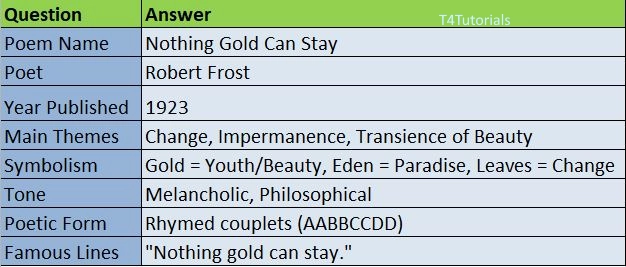Summary:
“Nothing Gold Can Stay” is a short yet deeply meaningful poem by Robert Frost, first published in 1923 in his poetry collection New Hampshire. The poem captures the fleeting nature of beauty, youth, and innocence.
Frost uses the changing seasons as a metaphor for the inevitability of change and decay. The poem begins with nature’s early gold, symbolizing the freshness of life and beauty, but quickly transitions to how this golden moment fades away—just like spring turning into summer or youth fading into age.
Through simple yet profound imagery, Frost emphasizes the temporary nature of all things, making the reader reflect on the passing of time and the transient beauty of life.

10
Score: 0
Attempted: 0/10
Subscribe
Score: 0
Attempted: 0/10
Subscribe
| Question | Answer |
| Poem Name | Nothing Gold Can Stay |
| Poet | Robert Frost |
| Year Published | 1923 |
| Main Themes | Change, Impermanence, Transience of Beauty |
| Symbolism | Gold = Youth/Beauty, Eden = Paradise, Leaves = Change |
| Tone | Melancholic, Philosophical |
| Poetic Form | Rhymed couplets (AABBCCDD) |
| Famous Lines | “Nothing gold can stay.” |